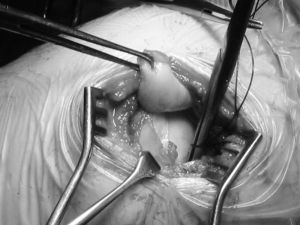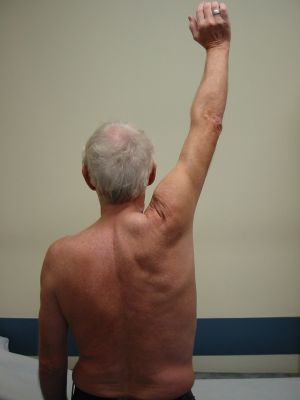|
Abstract:
The treatment of massive rotator cuff tears
remains controversial and difficult with a number of open and
arthroscopic techniques described in the literature. These are
associated with a high rate of failures. The differences in the
reported results vary significantly. 1,2,5,6
Lesions of the long head of biceps tendon are
commonly associated with rotator cuff tears. Using the biceps
tendon for repair in certain cases of massive rotator cuff tears
is a useful technique in the surgical armamentarium.
We describe the technique and results of two
cases. We suggest the name of Biceps Bridgeplasty for the
procedure of using the long head of biceps (LHB) for rotator
cuff repair.
J.Orthopaedics 2007;4(4)e16
index.htm
Case Report:
Case 1:
A 60 year old right handed man
was referred to us by the rheumatologists with a 3 month history
of reduced range of shoulder movement. Active abduction was 50°
and elevation till 70°. Passive range was slightly greater.
Ultrasound of the shoulder
confirmed a rotator cuff tear involving the supra and
infraspinatus. He was enrolled into a shoulder rehabilitation
programme. After 6 months of physiotherapy, there was no
significant improvement and surgical repair was therefore done
12 months from first presentation.
The rotator cuff tear was found
to be greater than 5 cm in size and was repaired using no.2
Panacryl and Mitek stich with the long head of biceps attached
to the rotator cuff.
At final follow up 14 months post surgery
forward elevation had improved from 70° to 120°, external
rotation from 5° to 15° and abduction from 50° to 95°. The
Constant score had improved from 27 to 66.
Case 2:
A 67 year old right handed man sustained a fall onto his
outstretched hand whilst on holiday and developed right shoulder
pain. He did not sustain any bony injury. The pain initially
improved but 9 weeks later developed severe pain whilst rotating
his shoulder and was unable to effectively abduct or elevate his
shoulder. He was admitted to another hospital for analgesia.
Ultrasound of his shoulder showed a rotator
cuff tear of greater than 5 centimetres in size involving the
supraspinatus and infraspinatus. He was subsequently treated
with analgesia and physiotherapy. Three months later there was
no significant improvement with elevation at 50° and abduction
at 60° and was referred here. He was operated 9 months post
injury.
At final follow up 12 months post surgery,
forward elevation had improved from 50° to 115°, external
rotation from 5° to 15° and abduction from 60° to 120°. His
Constant score had improved from 15 to 60.

Figure1: Biceps tendon being held
for the rotator cuff tear repair.

Figure2: Active abduction in
patient 2.
Technique:
With the patient in a beach chair
position a 5-6 cm lateral incision centered over the
acromioclavicular joint is made. After subcutaneous flaps have
been developed, the deltoid is split in line with its fibres
from just anterior to the AC joint extending distally for
approximately 5cm. using blunt dissection the subdeltoid
adhesions to the bursa are released and retractors placed. The
coracoacromial ligament is identified and excised. The deltoid
is elevated of the anterior acromion with its periosteal
attachment and a standard anterior acromioplasty is performed.
The rotator cuff tear is
identified and the cuff mobilised by blunt dissection. The
biceps tendon is tenodesed in the bicipital groove and divided
close to the glenoid origin. The rotator cuff is then sutured to
the biceps tendon in a double breasting fashion to draw the
supraspinatus as close to the fixed end of the biceps tendon as
possible.
The deltoid is then meticulously
repaired back using non absorbable sutures and standard skin
closure techniques are used.
The post operative regime depends
upon the quality of the tissues undergoing tendon repair and the
security of the sutures achieved. We placed the patients in a
shoulder sling with early passive motion beginning in the first
24 -48 hours for the initial 3 weeks. This is followed by active
motion for a further 3 weeks followed by isometric strengthening
excercises and unrestricted activities allowed at about 10-12
weeks postoperatively.
Discussion:
An irreparable tear of the rotator cuff is
described as a tear that cannot be repaired primarily by
reattachment of the torn cuff tendon to the greater tuberosity
after debridement of the avascular margin.2 Cofield
defined massive tears as those greater than 5 centimetres in
diameter. 8
Debridement of an irreparable and
massive cuff tears do provide some satisfactory results. There
however deteriorate with time and lead to cuff arthropathy in
the long term.1,6,7,8
Lesions of the long head of
Biceps tendon are frequently seen in association with rotator
cuff tears.3,4,7 The frequency of the MR(Magnetic
Resonance Imaging) findings in the biceps tendon is about 25%
while surgical correlation shows that this maybe as high as 75%,
when the whole spectrum of biceps lesions are considered,
ranging from mild tendonitis to complete rupture.4
The Biceps tendon is frequently subluxed and found to be
hypertrophied, flattened as it assumes the function of the
rotator cuff and its head depressor responsibility increases
thus making it more useful.3,4
The use of the biceps tendon for
irreparable defects of the rotator cuff was first proposed by
Bush in 1958.2 Various other surgeons have used the
Biceps tendon for repair of the rotator cuff tears in different
surgical techniques/ways.5,7 Using the biceps tendon
has several advantages, including treating the biceps tendon
itself, supporting the rotator cuff, improves the fixation
strength / security of repair and it works as a fixed head
depressor.
Both patients had significant
improvement in their Range of movement and had excellent
results. These cases highlight the importance of recognising the
presence of biceps tendon lesions in these patients and
considering its use in massive rotator cuff tears. Biceps
Bridgeplasty is thus a valuable tool in the armamentarium of the
shoulder surgeon.
Reference :
-
Bigliani LU, Cardasco FA,
Mcllveen SJ, Musso ES. Operative repair of massive rotator
cuff tears: long term results. J Shoulder Elbow Surg 1992; 1:
120-30.
-
Guven O, Bezer M, Guven Z, Kemal
G, Tetik C. Surgical technique and functional results of
irreparable cuff tears reconstructed with the long head of the
biceps tendon. Bull Hosp Jt Dis. 2001; 60(1): 13-7.
-
Nidecker A, Guckel C, von
Hoshstetter A. Imaging the long head of biceps tendon-a
pictoral essay emphasizing magnetic resonance. Eur L Radiol.
1997 Nov; 25(3); 177-87.
-
Chih-Hwa Chen, Kuo-Yaw Hsu,
Wen-Jer Chen, Chun-Hsiung Shih. Incidence ans severity of
biceps long head tendon lesion in patients with complete
rotator cuff tears. J Trauma. 2005: 58: 1189-1193.
-
Checchia SL, Doneux PS, Miyazaki
AN, Silva LA, Fregoneze M, Ossada A, Tsutida CY, Masiole C.
Biceps tenodesis associated with arthroscopic repair of
rotator cuff tears. J Shoulder Elbow Surg 2005; 14(2):
138-144.
-
Cofield RH, Parvizi J, Hoffmeyer
PJ, Lanzer WL, Ilsrup DM, Rowland CM. Surgical repair of
chronic rotator cuff tears: a prospective long term study. J
Bone Joint Surg. 83-A; 1: 71-77.
-
Wolfgang GL. Surgical repair of
tears of the rotator cuff of the shoulder: factors influencing
the result.
-
Gerber C, Fuchs B, Hodler J. The
results of repair of massive tears of the rotator cuff. J Bone
Joint Surg. 82-A; 4: 505-515.
|




